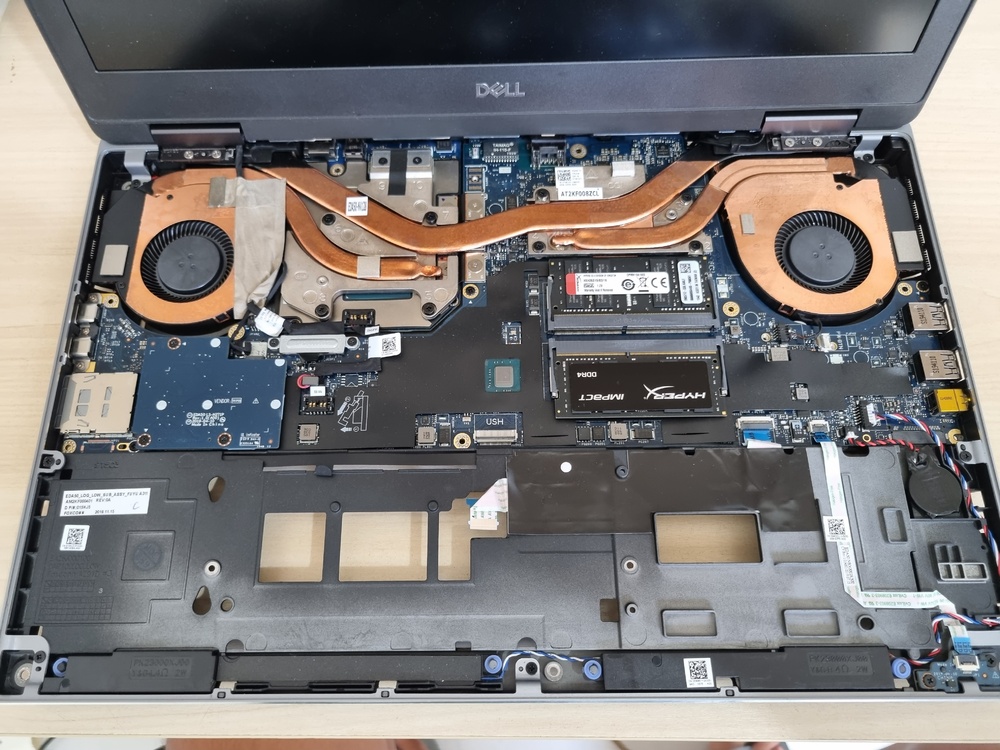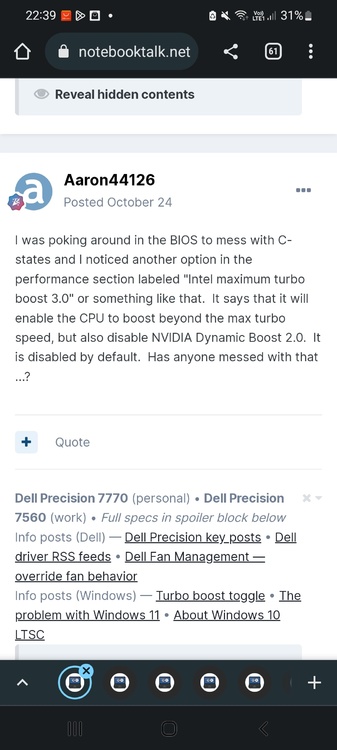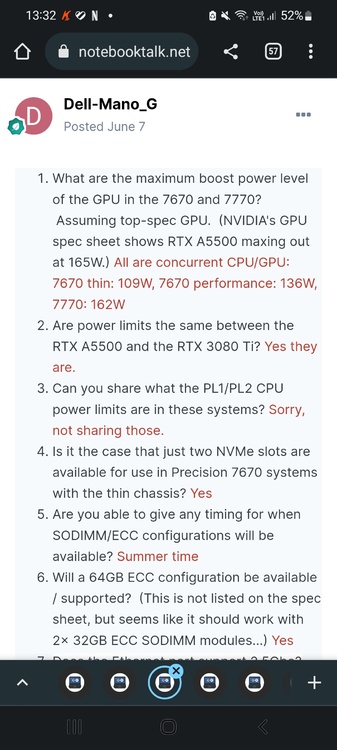
PHVM_BR
Member-
Posts
127 -
Joined
-
Last visited
Content Type
Profiles
Forums
Events
Everything posted by PHVM_BR
-
Precision 7540 & Precision 7740 owner's thread
PHVM_BR replied to SvenC's topic in Pro Max & Precision Mobile Workstation
I've opened this system a few times but not at the level of replacing the motherboard. I believe everything is fine. As for the price, I got a new one with i9-9880H for 340 US dollars. What do you think? -
Precision 7540 & Precision 7740 owner's thread
PHVM_BR replied to SvenC's topic in Pro Max & Precision Mobile Workstation
Thank you very much for the quick and detailed response! As for the gain or not with 8 cores, yes my load is multicore and yes I will have an expressive gain since with the i7 I still have a good thermal space. My consumption at full load with maximum clocks (4.0GHz all cores) is only ~60W with my undervolt setting and the PL1 is 75W. Furthermore, with PTM 7950 I can sustain up to 100W without thermal throttling (95-97ºC) in medium-term loads. I'd say 90W can be sustained all the time at 88-92ºC. -
Precision 7540 & Precision 7740 owner's thread
PHVM_BR replied to SvenC's topic in Pro Max & Precision Mobile Workstation
I have a CPU bottleneck in my workflow. 6 cores are slowing down my life and so I'm thinking of buying a motherboard with i9, or 9880H or 9980HK, for my Precison 7540 with i7-9750H and Quadro T2000. Is there anything I should be concerned about or just replace the motherboard and everything will work? My other option would be to buy another machine, but the Precision 7670/7680 didn't attract me. I believe with i9 with 8 cores it will serve me for another 2 or 3 years... -
Precision 5470 Anniversary Edition
PHVM_BR replied to wallstreetbets's topic in Pro Max & Precision Mobile Workstation
@Dell-Mano_G Any news about the launch of the Precision 5480? I had read that the date would be April 20th... -
Precision 7540 & Precision 7740 owner's thread
PHVM_BR replied to SvenC's topic in Pro Max & Precision Mobile Workstation
Maybe in the moments of change the level of rotation, but as I said, it doesn't bother me. I used the phase change pad version and I believe it is the best option to avoid flow out delivering long-term durability. -
Precision 7540 & Precision 7740 owner's thread
PHVM_BR replied to SvenC's topic in Pro Max & Precision Mobile Workstation
Unfortunately I never checked. It never bothered me, although at maximum speed it is quite high (~5100rpm). I last opened the laptop in February and did the repast with PTM 7950. I don't think I'm going to open it for a long time... The performance is fantastic! -
Precision 7540 & Precision 7740 owner's thread
PHVM_BR replied to SvenC's topic in Pro Max & Precision Mobile Workstation
In the case of the Precision 7540 with T2000 the heatsink is the same as the version with RTX3000? Good to know! -
Precision 7540 & Precision 7740 owner's thread
PHVM_BR replied to SvenC's topic in Pro Max & Precision Mobile Workstation
Does anyone know if the new BIOS 1.25.0 blocks the undervolt? -
The Beast Returns - Alienware m18 - i9 13980HK 24c/RTX 4090 Mobile
PHVM_BR replied to ssj92's topic in Alienware 18 and M18x
I intend to buy, but these 139xxHX without undervolt are uncontrollable thirsty beasts. With undervolt I believe to minimize this and maintain a (high) power consumption in a more stable way and still increase the multicore performance. Without undervolt I will skip this generation more or go for a Ryzen 9 7945HX. -
The Beast Returns - Alienware m18 - i9 13980HK 24c/RTX 4090 Mobile
PHVM_BR replied to ssj92's topic in Alienware 18 and M18x
Does anyone have a precise answer if the undervolt is unlocked on the m16's 13900HX? With the unlocking of the overclock in the BIOS is the undervolt possible? -
Precision 7540 & Precision 7740 owner's thread
PHVM_BR replied to SvenC's topic in Pro Max & Precision Mobile Workstation
I use my 7540 i7-9750h with 100% stable undervoltage of -130mV in cache and -250mV in core. The difference to stock is brutal....especially with regard to temperatures. Cinebench R23 multicore under the same conditions: Stock = ~7900 initial: 90W / ~3.85GHz / ~93°C after ~30s: 75W / ~3.65GHz / ~84°C Subtension = ~8300 ~62W / 4.00GHz / ~77°C https://hwbot.org/benchmark/cinebench_-_r23_multi_core_with_benchmate/rankings?hardwareTypeId=processor_5870&cores=6#start=0#interval=20 -
Precision 7540 & Precision 7740 owner's thread
PHVM_BR replied to SvenC's topic in Pro Max & Precision Mobile Workstation
Yes, my unit came from the factory with only 1 SSD, but with all 3 heatsinks. -
The Beast Returns - Alienware m18 - i9 13980HK 24c/RTX 4090 Mobile
PHVM_BR replied to ssj92's topic in Alienware 18 and M18x
Alienware m16 QHD+ 240Hz Gaming Laptop 13th Gen Core i9 16GB Memory NVIDIA GeForce RTX 4080 1TB SSD Dark Metallic Moon AWM16-9272BLK-PUS - Best Buy -
Intel HX processors have UHD Graphics 770, which is a limited version of Iris Xe with only 32EUs. As with the Iris Xe G7, up to 3 monitors plus the internal screen are possible. Up to 4K@60Hz via HDMI and up to 8K@60Hz via DP. https://www.intel.com/content/www/us/en/products/sku/228439/intel-core-i912950hx-processor-30m-cache-up-to-5-00-ghz/specifications.html https://www.notebookcheck.net/Intel-UHD-Graphics-770-Alder-Lake-GPU-Benchmarks-and-Specs.633858.0.html
-
Locking CPU power to low values is a way to force Dynamic Boost to act at full capacity on limited systems (temperature and/or power). If even limiting the cpu to 30W the maximum TGP is not reached, there is something beyond that only Dell can answer... Even with the power supply limited due to the 240W adapter, sustained 130+W on the 3080Ti should be possible with the processor limited.
-
@MyPC8MyBrain This GPU limitation on the 2022 Precision 7000 is somewhat obscure. As far as I know, the 2021 RTX has Dynamic Boost up to 15W and this has been increased to up to 25W in the 2022 releases (3080Ti included). The Nvidia control panel reports the maximum TGP of 150W (base TGP + Dynamic Boost) so the base TGP should be at least 125W. @Dell-Mano_G Could you comment on the limitations reported by several owners?
-
I understand that this answer from Dell-Mano_G means that there is a fixed, locked, limit on CPU+GPU power of 162W. From your videos I believe that the limit is activated with high loads on the GPU. Have you tested with Intel Power Max Turbo Boost 3.0 disabled? https://notebooktalk.net/topic/632-dell-precision-7670-dell-precision-7770-owners-thread/?do=findComment&comment=17016&_rid=574 perhaps this limitation on joint CPU and GPU loads can be removed with a BIOS mod... It really is very disappointing. I expected on the 7770 at least 180W on the CPU + GPU simultaneously, with values varying between 125+55W and 150+30W. And without a deliberate blocking of that value...
-
If the total power limit (CPU+GPU) is 170W you cannot lock the PL1/PL2 to 55 or 65W because that will make the TGP stay at the base value without the extra power of the Dynamic Boost. For Dynamic Boost to work the processor power must be ~30W to leave ~140W for the GPU. Without blocking power caps with ThrottleStop on other systems (depends on Dynamic Boost implementation) at high simultaneous CPU/GPU loads GPU power should run at values between its base TGP and maximum TGP (base TGP + Dynamic Boost) and the power of the processor will vary completing the 170W (in this case) according to the demand. Enough theory for today. Good luck with your adjustments! @MyPC8MyBrain Take a look: https://notebooktalk.net/topic/23-precision-7670-7770-pre-release-discussion-alder-lake/?do=findComment&comment=8307&_rid=574
-
You didn't understand what i wrote. Probably due to my limited (terrible) English... In TS cpu test GPU load (%) is low. The imposition of the CPU + GPU power limit (~170W) only comes into play at high GPU loads (like in the TS graphics tests). All this according to my theory. If you want to confirm whether it's right or not, just follow the real-time CPU and GPU power consumption data during TS. There is no point in checking at the end that the maximum consumption of the CPU was 157W and the GPU was 120W as this is not achieved simultaneously.
-
I believe it's not a thermal cap or power cap issue, it's an imposition of CPU + GPU summed TDP at high GPU loads. Games or TimeSpy for example. My theory is that in the TS cpu test this limit doesn't come into play because the load on the GPU is low. So your CPU reaches 157W + X Watts from the GPU + X Watts from the rest of the system resulting in ~225/230W. Already in the graphics tests, the GPU must be consuming ~120W and the processor limited to ~50W, resulting in ~170W and making it impossible for Dynamic Boost to come into action.




